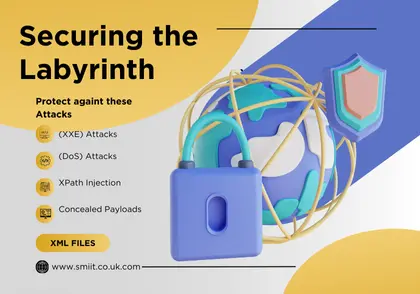
Securing the Labyrinth: Shielding XML Data in SAP Environments
The digital age has ushered in a data-driven era, where information reigns supreme. As a result, cybersecurity has become a cornerstone for businesses of all sizes, safeguarding valuable assets in a landscape rife with cyber threats. Yet, within the intricate world of SAP applications, a crucial aspect often flies under the radar: the management and security of XML files.
XML: A Double-Edged Sword
Extensible Markup Language (XML) stands as a versatile and ubiquitous format for encoding documents in a machine-readable way. Its very flexibility, however, presents a double-edged sword. While it simplifies data exchange and configuration, it also creates potential entry points for cyberattacks.Unveiling the Hidden Dangers Within SAP Ecosystems
SAP applications, renowned for their robustness in managing business operations, heavily rely on XML for data interchange and configuration. The vast amount of sensitive information processed by these applications makes them prime targets for malicious actors. The risks associated with XML files in this context are multifaceted and demand careful consideration.XML External Entity (XXE) Attacks: A Breach in the Wall
Imagine a well-fortified castle. XXE attacks exploit vulnerabilities in XML parsers, akin to weak points in the castle walls. Malicious actors can leverage these vulnerabilities to smuggle in unauthorized entities, potentially stealing sensitive data or executing malicious code. In the context of SAP applications, this can lead to data breaches or complete system compromise.Denial-of-Service (DoS) Attacks: A Digital Siege
DoS attacks function like a relentless siege on a castle. Crafted malicious XML files can overwhelm parsers with excessive data, causing service degradation or complete system failure. These attacks, also known as XML Bombs, can cripple business operations and incur substantial financial and reputational damage. Imagine a seemingly ordinary cartload of supplies, upon closer inspection, turns out to be meticulously constructed to overload the castle gates, preventing legitimate traffic from entering.XPath Injection: Hijacking the Search Party
Within a castle, guards rely on specific protocols to locate individuals. XPath queries function similarly, navigating the structure of XML documents. Attackers can manipulate XPath queries within XML files to access or modify unauthorized data, leading to leaks or manipulation. This is akin to tricking the guards into leading them to restricted areas or manipulating information within the castle.Data Exfiltration & Concealed Payloads: The Trojan Horse of the Digital Age
Base64 encoding allows embedding binary data like executables within XML files. Malicious actors can exploit this for data exfiltration or payload delivery. Imagine concealing a small army within a seemingly harmless gift horse, only to unleash them upon entry. Similarly, attackers can embed malicious code within XML files, evading detection mechanisms and leveraging XML parsers to decode and execute the concealed content, potentially compromising systems.Cross-Site Scripting (XSS) & Injection Attacks: Exploiting Web Interfaces
Base64-encoded data within XML files can be vulnerable to XSS attacks if rendered in web interfaces. Attackers can inject malicious scripts to steal data or perform unauthorized actions. This is akin to exploiting vulnerabilities in the castle's communication channels to gain unauthorized access or spread misinformation.XSLT Injection Attacks: A Subversion of Transformation
Extensible Stylesheet Language Transformations (XSLT) enables transforming XML documents into different formats.Attackers can exploit vulnerabilities to inject malicious code for unauthorized access, data manipulation, or system compromise. Imagine an architect tasked with renovating specific sections of the castle, who instead uses the opportunity to introduce structural weaknesses that compromise the castle's integrity.Fortifying the Defenses
Robust XML Parsing: Configure parsers to disable external entity resolution and DTD processing to mitigate XXE attacks. Rigorously test and configure SAP applications to withstand such exploitation attempts.Validation & Sanitization: Scrutinize and clean all XML inputs to prevent injection attacks. Utilize schemas or whitelists to define acceptable XML structures and content, ensuring only legitimate documents are processed. Monitoring & Analysis: Continuously monitor XML traffic for suspicious patterns. Unusual data sizes or unexpected changes in XML structures should trigger alerts. Equip SAP systems with monitoring tools to detect anomalous XML activity. Education & Training: Raise awareness among staff and developers regarding XML file risks and promote secure coding practices. Regular training sessions can instill best practices for handling XML data securely.
While XML files are vital to the SAP application ecosystem, they are not immune to cyber threats. A proactive, informed, and layered security strategy is essential to safeguard these assets against the sophisticated cyber threats of today's digital landscape. By acknowledging the risks and implementing comprehensive security measures, businesses can leverage the power of XML and SAP applications while maintaining a robust cybersecurity posture.
SMIIT







.jpg)
